Transparency International Ukraine’s Transparent Cities program has presented the results of the 2024 Transparency Ranking, assessing how cities performed during the full-scale war. Analysts evaluated 100 municipalities across 21 regions of Ukraine based on 70 criteria.
Chernivtsi topped the ranking with 84.5 out of 100 points, demonstrating significant progress — an increase of 27.1 percentage points over the year.
Vinnytsia ranked second with 81 points, followed by Lutsk in third place with 76 points.
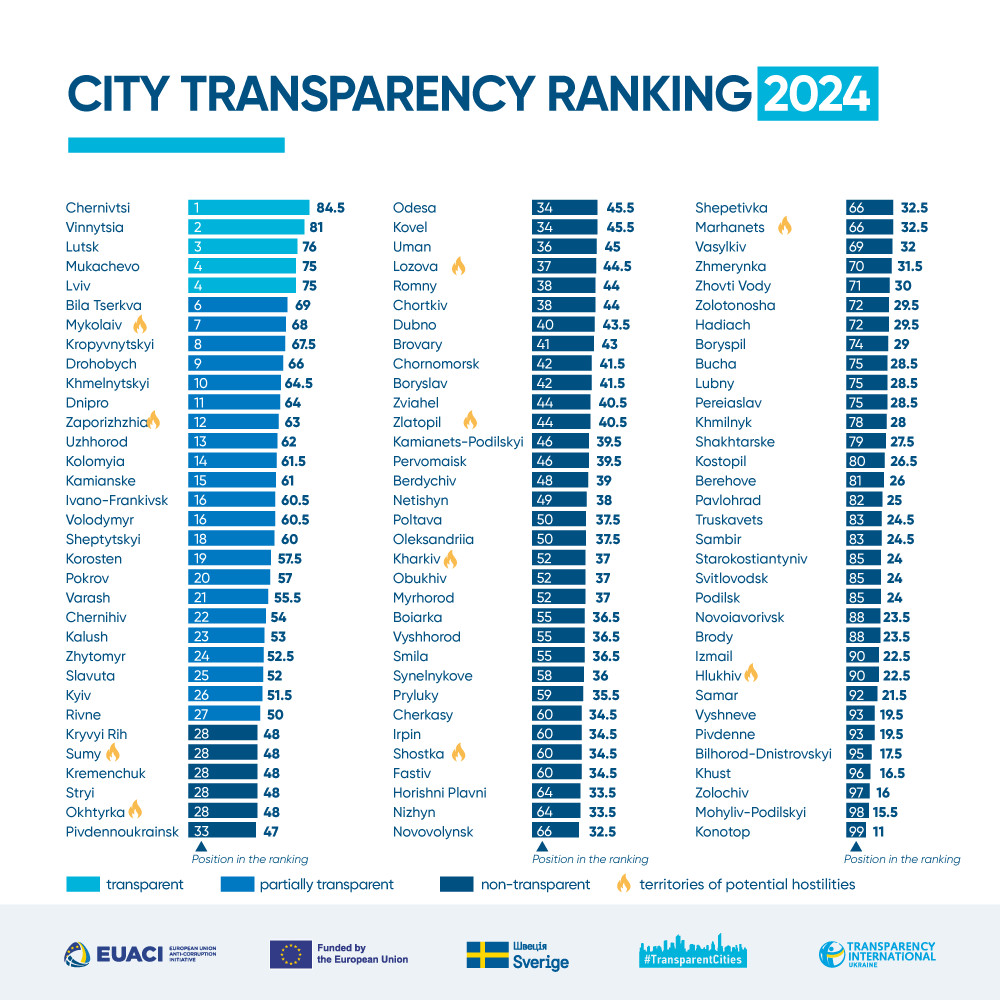
The average level of city transparency constitutes 41.6%.
Large cities demonstrated the highest average transparency level at 59.1%, compared to 41.7% for medium-sized cities and 33.2% for small cities.
Only four cities with a population of up to 50,000 achieved the status of “partially transparent”: Volodymyr (60.5 points), Pokrov (57 points), Varash (55.5 points), and Slavuta (52 points).
In 2024, 100 cities were assessed, 78 of which also participated in the 2023 study, when the average transparency level was 42.2%. In 2024, the average transparency level of these 78 municipalities increased to 45.4%.
The top ten includes seven regional centers and three non-regional cities. In addition to the five transparent ones, these include the partially transparent Bila Tserkva (69), Mykolaiv (68), Kropyvnytskyi (67.5), Drohobych (66), and Khmelnytskyi (64.5).
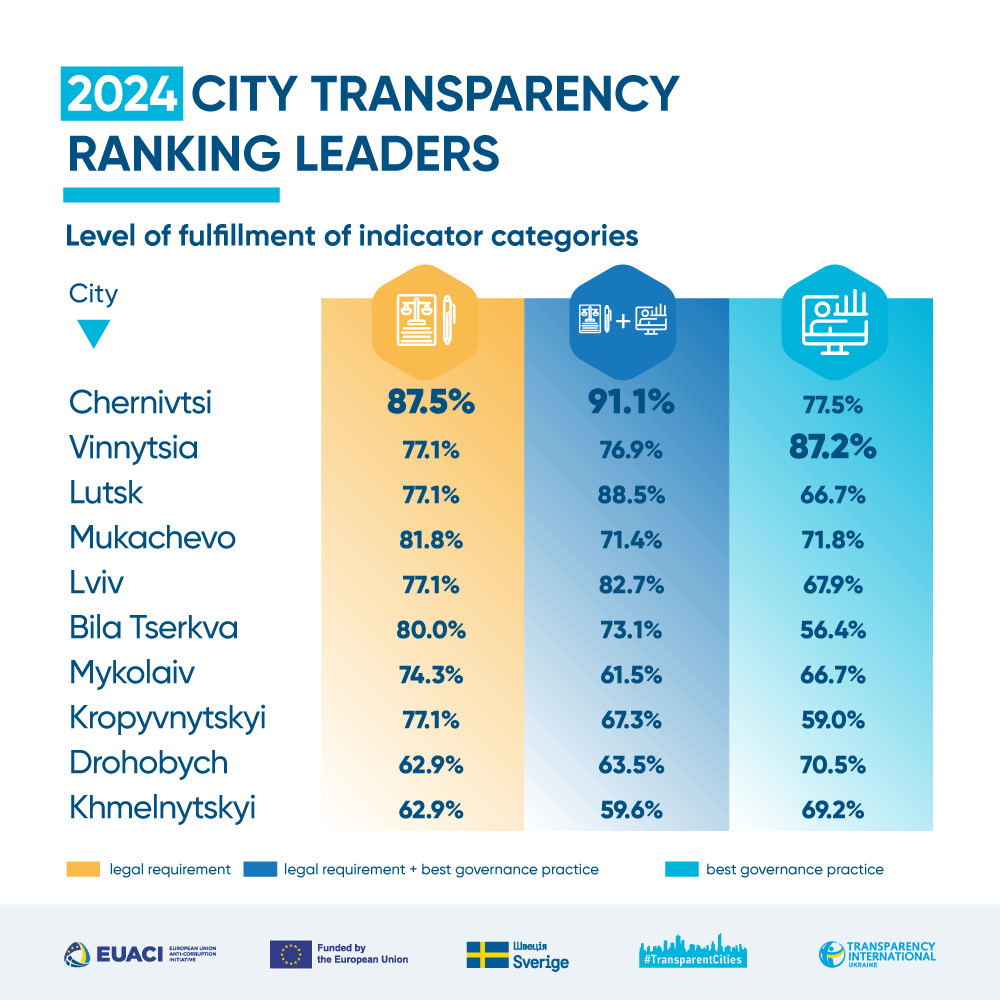
Analysts also evaluated 10 cities designated as territories of potential hostilities. Their average transparency level was 43.9%, slightly above the overall average. Eight frontline municipalities that participated in both the 2023 and 2024 studies demonstrated greater overall progress in increasing their transparency levels in 2024.
Mykolaiv and Zaporizhzhia were classified as “partially transparent,” while the remaining eight frontline cities — Hlukhiv, Zlatopil, Lozova, Marhanets, Okhtyrka, Sumy, Kharkiv, and Shostka — were deemed “non-transparent.” Mykolaiv demonstrated significant progress, ranking 7th with 68 points.
At the same time, Zaporizhzhia showed the most notable progress over the year, rising to 12th place due to a 27.3 percentage point increase in its score. Sumy (+16.4 p.p.) and Marhanets (+12.7 p.p.) also improved their results.
Cities performed best on indicators that combine legal requirements with best governance practices, with an average implementation rate of 45%. Slightly lower was the performance on indicators related solely to legal requirements — 44.1%.
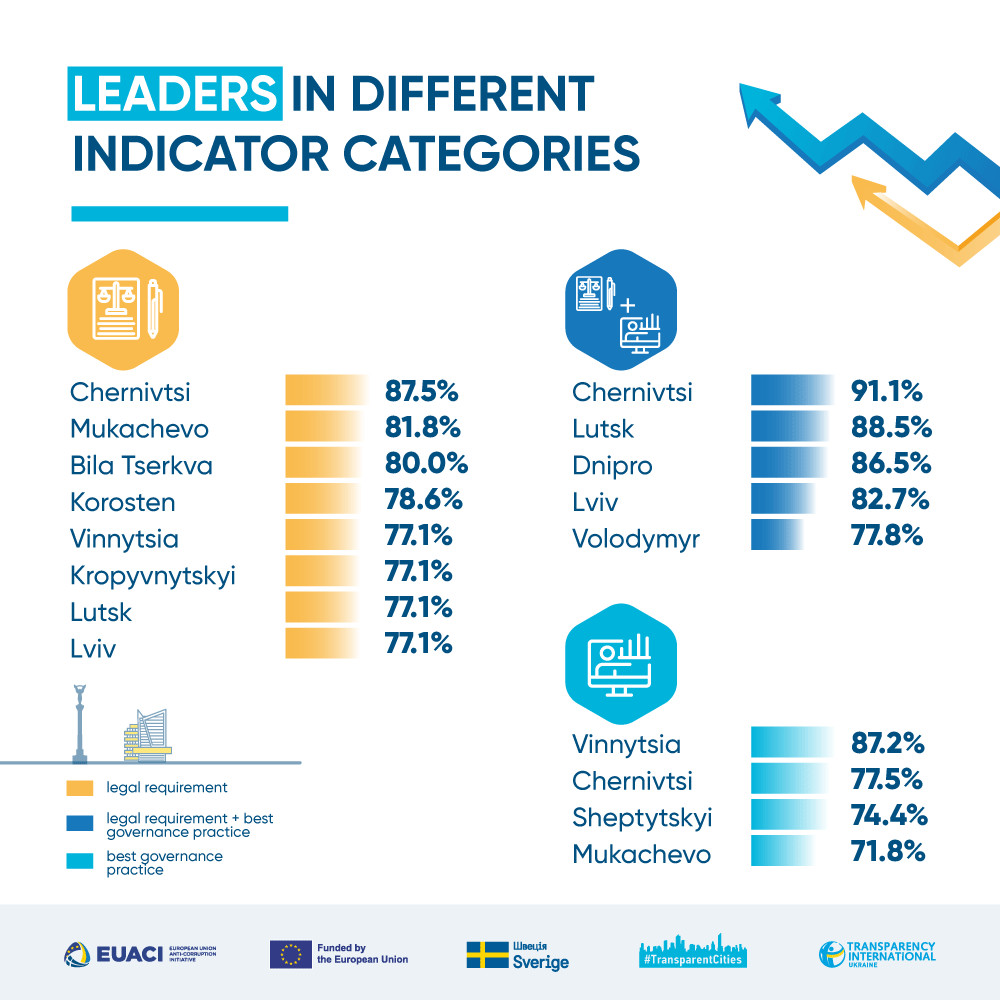
However, indicators reflecting best practices not yet mandated by law were implemented at an average rate of only 37.1%. This suggests that cities still have significant room for improvement, especially considering that compliance with legally established indicators is mandatory.
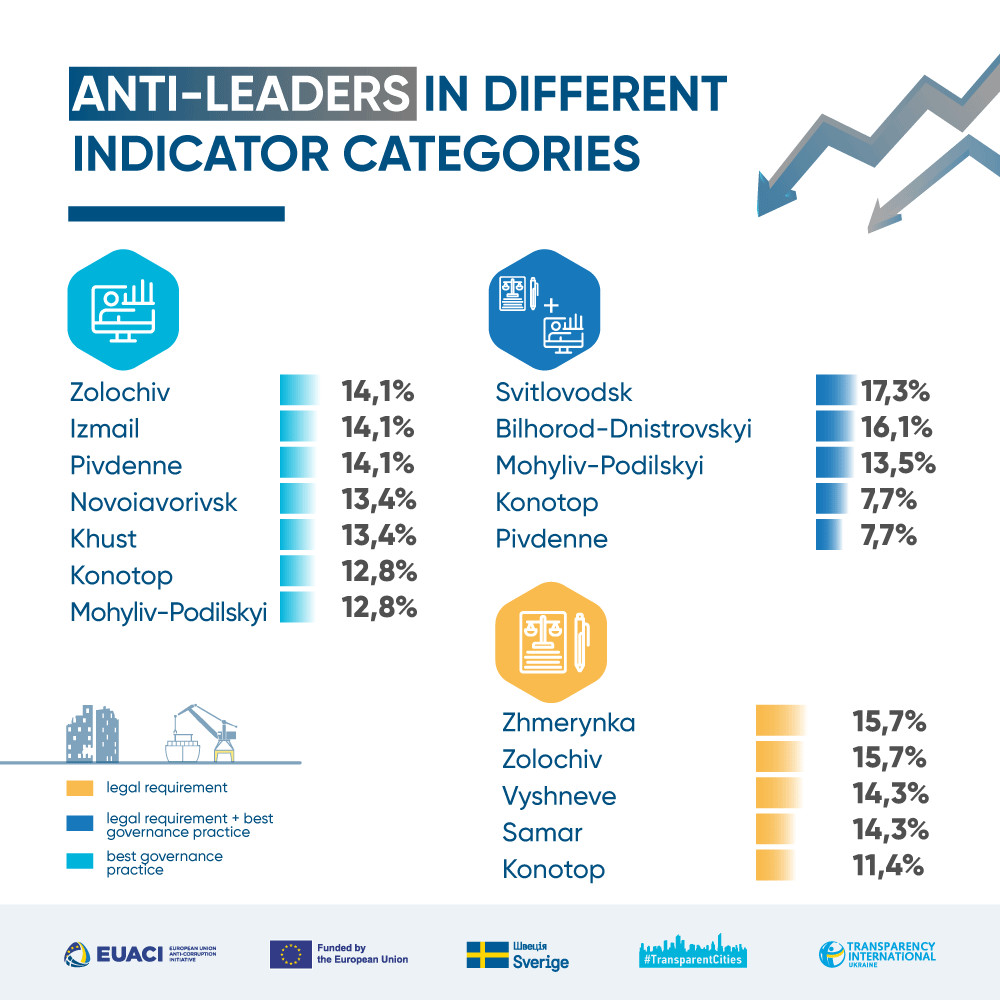
It is worth highlighting several noteworthy achievements of Korosten that fully implemented 72.7% of the indicators related to legal requirements, Volodymyr and Kamianske each implemented 70.6% of the indicators that combine legal obligations with best practices, and Sheptytskyi that achieved full compliance with 71% of the indicators assessing the implementation of best governance practices.
However, out of the 100 cities studied, 72 remained classified as non-transparent. The worst results were gained by Konotop (11 points out of 100 possible), Mohyliv-Podilskyi (15.5), Zolochiv (16), Khust (16.5), Bilhorod-Dnistrovskyi (17.5), Pivdenne and Vyshneve (19.5 each), Samar (21.5), Hlukhiv, and Izmail (22.5 each).
Compared to 2023, six cities fell into the lowest category: two lost their status as “transparent,” and four others lost their “partially transparent” status.
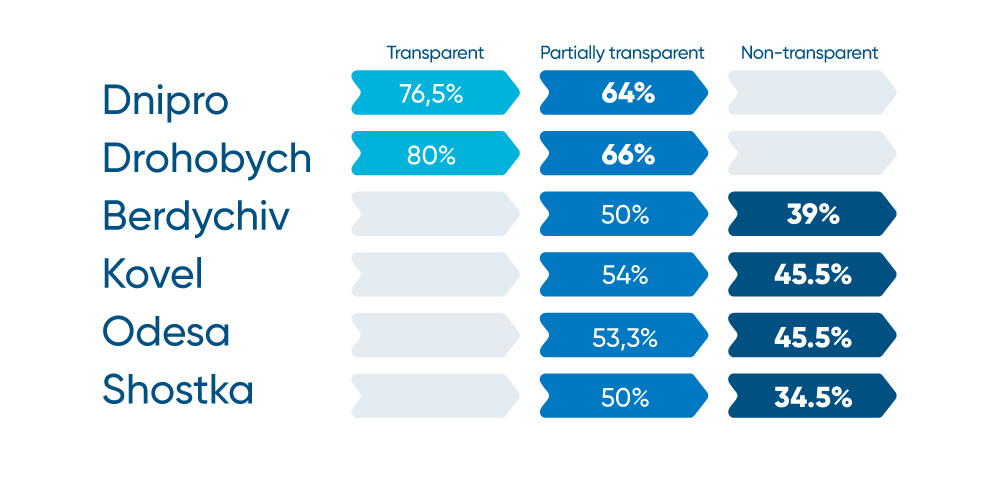
The most significant declines were recorded in Shostka (–15.5 p.p.) and Drohobych (–14 p.p.), according to analysts.
Indicators not included in the 2023 study proved to be a stumbling block for Dnipro and Drohobych, which had previously been ranked as “transparent.” The implementation of new criteria provided 47 to 50 points out of 100 possible. Of the 16 indicators not implemented by the Dnipro City Council, 13 (81.3%) were newly introduced. Similarly, of the 14 indicators Drohobych failed to meet, 10 (71.4%) were new.
Vinnytsia and Chernivtsi successfully fulfilled the largest number of newly introduced indicators. Vinnytsia met 79.4% of all new criteria, while Chernivtsi implemented 75%. This strong performance contributed to their leading positions in the ranking.
Across all areas, cities demonstrated the strongest performance in indicators related to openness (43.6%), public relations (41.7%), and response to war-related challenges (39.6%).
The weakest performance was observed in the following areas: services to citizens — with 67% of indicators not implemented; municipal property and land — 61.1%; and HR policy and integrity — 60.3%.
Analysts also examined data from eight years of assessments, allowing them to distinguish between real impact and formal compliance, identify the true drivers of change, and understand how transparency is influenced by systematic efforts, wartime conditions, and the adaptability of local self-government.
One of the findings revealed a moderate correlation between transparency levels and factors such as financial capacity, population size, or region. However, no correlation was observed between transparency and the number of air raid alerts. Above all, a city's level of transparency depends on the political will of its leadership and the consistency of efforts to implement effective transparency mechanisms.
At the same time, transparency proved to be a key component of community resilience: municipalities that had systematically worked to improve it before the full-scale invasion were better equipped to withstand the challenges of war and adapt to new conditions.
The program has developed recommendations for cities to help enhance their transparency under wartime conditions and support Ukraine’s successful European integration. They include:
- Regularly and proactively announce meetings of the city council, executive committee, and standing committees; publish their minutes and decisions; and ensure the live broadcast of these events.
- Disseminate information on decisions to provide compensation for damaged or destroyed real estate.
- Publishing title lists for major and current repairs, construction, reconstruction, and improvement; a list of municipal land plots proposed for transfer to the ownership of citizens and legal entities or granted for use; a register of movable properties in municipal ownership.
- Develop a clear procedure to ensure citizens’ access to open plenary sessions of the city council.
- Establish a structured process for publishing open data, approve the necessary policies and procedures, and develop services based on high-quality, timely datasets published by local self-government bodies.
- Ensure the continuous operation of the e-petition platform and provide proper moderation and timely responses to submitted petitions.
- Introduce an electronic system for registering applications for housing and enrollment in municipal educational institutions.
- Publish complete and timely information about vacancies, job competitions, and internship opportunities for young people.
- Ensure transparent accounting and distribution of humanitarian aid coming to municipalities.
- Develop and implement a local anti-corruption mechanism, and appoint a dedicated body or official responsible for monitoring the ethical conduct of local government officials.
- Establish an independent body for internal control and auditing of city council divisions, and ensure the publication of inspection results.
- Adopt key strategic documents, including the Municipal Energy Plan and the Plan for the Restoration and Development of the Territorial Community
Read more in the full text of the study:
This research was prepared within the framework of the institutional development program of Transparency International Ukraine, implemented with financial support from Sweden and the European Union Anti-Corruption Initiative (EUACI) — an anti-corruption program funded by the EU, co-financed and implemented by the Danish Government.
The research outcomes are the responsibility of the authors and do not necessarily reflect the views of the EU or the Governments of Sweden and Denmark.
Transparency International Ukraine is an accredited chapter of Global Transparency International. Since 2012, TI Ukraine has been helping Ukraine grow stronger. The organization takes a comprehensive approach to the development and implementation of changes for reduction of corruption levels in certain areas.
TI Ukraine launched the Transparent Cities program in 2017. Its goal is to foster constructive and meaningful dialogue between citizens, local authorities, and the government to promote high-quality municipal governance, urban development, and effective reconstruction. In 2017–2022, the program annually compiled the Transparency Ranking of the 100 largest cities in Ukraine. After the full-scale invasion, the program conducted two adapted assessments on the state of municipal transparency during wartime. In 2024, the program resumed the creation of the transparency ranking for 100 cities and launched a new study, “Open Data Pulse: Ukrainian Cities Ranking.” The program produces high-quality analytics on various aspects of government-citizen interaction, as well as transparency and accountability in Ukrainian cities. This includes, in particular, processes such as decolonization, housing policy, and more.